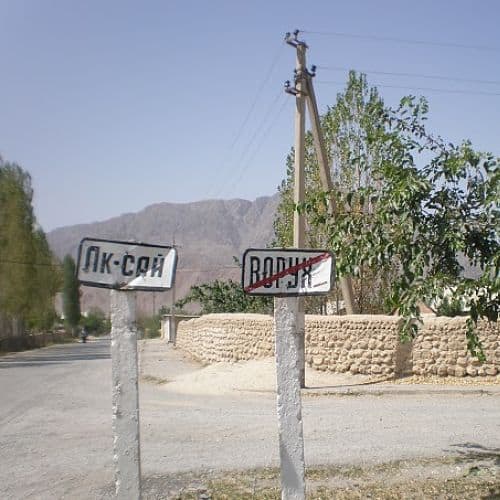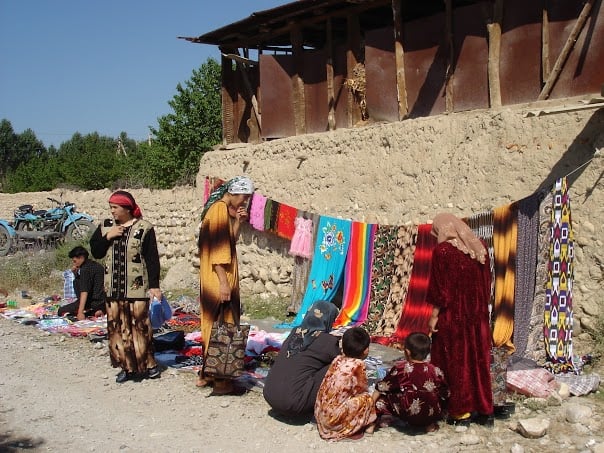In contemporary political anthropology, ‘the state’ is a curious as if object (Navaro-Yashin 2002). It has come to dominate the sub-discipline since the 1990s. Students of the state have continued to grapple with its intransigent ambiguity originally captured in Thomas Hobbes’ image of the Leviathan: the tension between the state’s apparent total reality and its only ever partial experience through particular events or practices. Thus the state remains a compelling field of study for anthropologists, despite decades of deconstruction through theory and ethnography. In recent years, one productive approach has been to study the state ethnographically in and through its margins (Das and Poole 2004) – the sites and practices where the state’s presence is experienced as discontinuous and problematic. Such situations cast in sharp relief the ways the state is produced and maintained in daily life. Border Work: Spatial Lives of the State in Rural Central Asia by Madeleine Reeves is an original and incisive contribution to this literature.
 Clearly, international borders are one very salient kind of ‘margin’. Borders are where states begin and end, on the map, but also politically and existentially, as distinct areas where particular legal, ideological, and economic regimes condition human lives. Reeves’ recent book takes border studies into new territory, both literally, in the sense of a part of the world little explored so far, and figuratively, by asking empirical and theoretical questions which have rarely, if ever, been asked. While studies so far have generally focused on heavily securitised and technologically advanced borders of the central regions of the present world-system, such as the borders of the United States and the outside borders of the European Union (e.g. Romero 2008), Reeves studies borders in the remotest, arid corners of rural Central Asia – a region which has only recently began to be charted with increased attention by anthropologists with focus on the political (cf. Reeves, Rasanayagam and Beyer (2014).
Clearly, international borders are one very salient kind of ‘margin’. Borders are where states begin and end, on the map, but also politically and existentially, as distinct areas where particular legal, ideological, and economic regimes condition human lives. Reeves’ recent book takes border studies into new territory, both literally, in the sense of a part of the world little explored so far, and figuratively, by asking empirical and theoretical questions which have rarely, if ever, been asked. While studies so far have generally focused on heavily securitised and technologically advanced borders of the central regions of the present world-system, such as the borders of the United States and the outside borders of the European Union (e.g. Romero 2008), Reeves studies borders in the remotest, arid corners of rural Central Asia – a region which has only recently began to be charted with increased attention by anthropologists with focus on the political (cf. Reeves, Rasanayagam and Beyer (2014).
It is a region where borders criss-cross and meander, creating a jigsaw-puzzle or ‘chessboard’ of different state’s territories. In the first two chapters of her book, Reeves charts the complex history of how this came about. Throughout the twentieth century, the Westphalian logic of borders-as-lines separating states and, presumably, ethnically distinct populations, was gradually introduced in Central Asia. Today, as a legacy of Soviet-era ethno-territorial formation, the Ferghana Valley, in particular, is divided between three states: Kyrgyzstan, Uzbekistan, and Tajikistan. The pattern of meandering borders, enclaves, and exclaves means that a local road between two neighbouring towns or an irrigation canal is likely to cross international borders multiple times.
However, for all the abundance of borders on the map, Reeves shows how borders on the ground are works in progress. They are not simply contested – they literally materialise and dematerialise from one moment to the next.
As Reeves’ title captures, moreover, it is in every case the result of work – the work of demarcation, manning, patrolling, fixing, checking passports, placing or removing border posts, signs, and barbed wire; building or destructing roads and bridges; negotiating passage and carrying items which may rapidly shift in status between legitimate trading stock and contraband. Through an extremely fine-grained ethnography of these diverse practices – some of them mundane, some, she shows, highly charged with violence and affect – Reeves challenges the way we think about borders. She explores not only the spatiality of borders – where they run and what areas they separate – but also their temporality, borders as events: how borders are made and unmade, how they appear and disappear with distinct rhythms for specific groups of people. Moreover, Reeves studies the nitty-gritty materiality of the border. She shows how a border is not an abstract line, but an often fragile, rough-and-ready arrangement that may consist, for instance, ‘of a pair of conscript soldiers with Kalashnikov rifles, a paper ledger, and a stamp’ (p.7).
From later chapters of Reeves’ book, we learn about how these multiple borders are enacted, experienced, and produced in daily life. We are invited to follow the often arbitrarily interrupted flow of irrigation water, export apricots, and remittances – the bases of local livelihoods – across international borders. We learn about the ingeniousness of transnational labour migrants and the precariousness of the grey zones between legality and illegality, visibility and invisibility to the eyes of officials in charge of enforcing border regimes. Further, Reeves describes everyday interactions with guards at the newly-emerged borders in rural Ferghana Valley. She shows the arbitrariness with which they permit or deny passage to local residents, the danger of those encounters, but also the guards’ entanglement in criss-crossing loyalties, obligations, moral customs, hierarchies of age and gender, and networks of economic relations.
Finally, Reeves studies a moment of violent intercommunal conflict which led to the bounding of state on local ground by separating a once-shared market place, separating local roads, and augmenting military presence on the border, with repercussions for the mobility of local residents – in particular women’s access to healthcare.
 Reeves puts this very rich ethnographic material into critical conversation with a broad range of theory, working across numerous boundaries of a different kind: those between academic disciplines. What emerges is an original argument about the productivity of borders: a rethinking, through the prism of these particular ‘margins’ of the state, of how space is turned into territory, how sovereignty is produced through daily impersonations and improvisations at the border, and how state-formation is forever a work-in-progress.
Reeves puts this very rich ethnographic material into critical conversation with a broad range of theory, working across numerous boundaries of a different kind: those between academic disciplines. What emerges is an original argument about the productivity of borders: a rethinking, through the prism of these particular ‘margins’ of the state, of how space is turned into territory, how sovereignty is produced through daily impersonations and improvisations at the border, and how state-formation is forever a work-in-progress.
Border Work is essential for anyone interested in theorising and critiquing the state and sovereignty, as well as for all students of the politics of space. It offers a set of novel, incisive arguments grounded in first-class ethnography. Finally, thanks to Reeves’ light and elegant prose – the book is a page-turner. A must-read.
Subtitles to photographs by Madeleine Reeves
Header image: The Kyrgyzstan/Tajikistan boundary at Ak-Sai/Vorukh in 2008. There still remains no permanent physical marker other than the signs giving the name of the village to indicate that this is the international border at the entrance to the Vorukh enclave. However, following a deterioration in cross-border relations since the late 2000s, the road is now regularly manned by soldiers and citizens of Kyrgyzstan rarely cross into Vorukh.
1) Border market at Tojikon/Bakai in 2005. In the mid-2000s, a regular border market occurred here at the border between the Tajik village of Tojikon and the Kyrgyz village of Bakai. Many of the land parcels in this region, loaned for “long-term use” between collective farms in the 1970s, remain officially disputed between the two states.
2) Tyre-ferry across the Shahrihan say canal at Kara-Suu (Kyrgyzstan/Uzbekistan border, 2003). Following the dismantling of the passenger bridge across the 12-metre wide canal, informal “tyre-ferries” appeared, in which people and good could be transported across the canal to the large wholesale market on the Kyrgyz side of the border. Opportunities for cross-border movement have deteriorated considerably following inter-communal conflict in the Southern Kyrgyzstani city of Osh in the summer of 2010.
Reeves, Madeleine. 2014. Border Work: Spatial Lives of the State in Rural Central Asia. Series: Culture and Society after Socialism. Ithaca: Cornell University Press. 312 pp. Pb: $29.95. ISBN 978-0-8014-7706-5.
References
Das, Veena, and Deborah Poole, eds. 2004. Anthropology in the Margins of the State. Santa Fe: School of American Research Press.
Navaro-Yashin, Yael. 2002. Faces of the State: Secularism and Public Life in Turkey. Princeton: Princeton University Press.
Reeves, Madeleine, Johan Rasanayagam and Judith Beyer, eds. 2014. Ethnographies of the State in Central Asia: Performing Politics. Bloomington: Indiana University Press.
Romero, Fernando. 2008. Hyperborder: The Contemporary U.S. – Mexico Border and Its Future. New York: Princeton Architectural Press.




